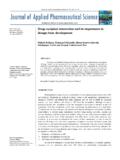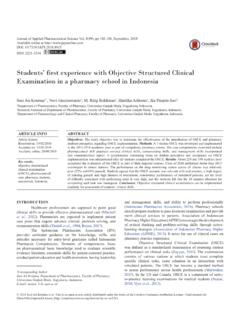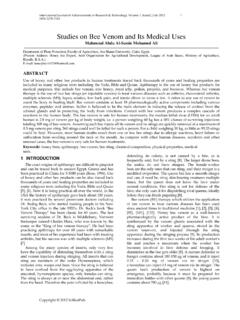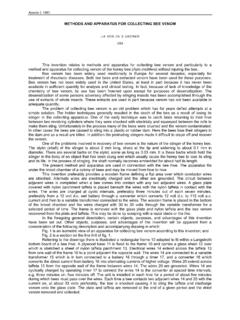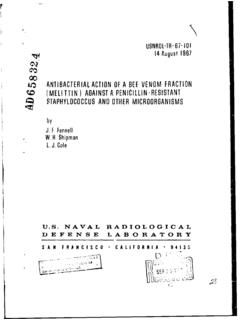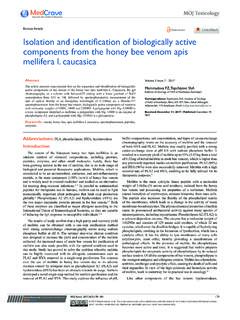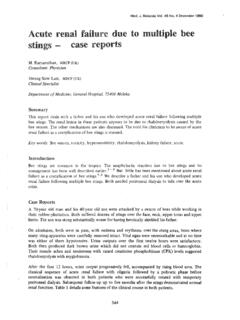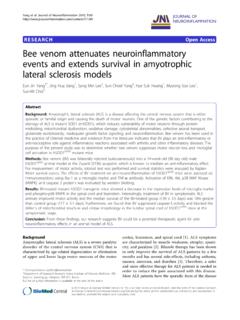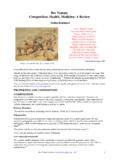Transcription of Role of bee Venom Acupuncture in improving pain …
1 2017 Aliaa El Gendy et al. This is an open access article distributed under the terms of the Creative Commons Attribution License -NonCommercial-ShareAlikeUnported License ( ). Journal of Applied Pharmaceutical Science Vol. 7 (08), pp. 168-174, August, 2017 Available online at DOI: ISSN 2231-3354 Role of bee Venom Acupuncture in improving pain and life quality in Egyptian Chronic Low Back Pain patients Aliaa El Gendy1, Maha M. Saber1, Eitedal M. Daoud1, Khaled G. Abdel-Wahhab2, Eman Abd el-Rahman3, Ahmed G. Hegazi4* 1 Complementary Medicine Department, National Research Centre, Giza, Egypt. 2 Medical Physiology Department, National Research Centre, Giza, Egypt. 3 Parasitology Department, National Research Centre, Giza, Egypt. 4 Zoonotic Diseases Department, National Research Centre, Giza, Egypt. ARTICLE INFO ABSTRACT Article history: Received on: 26/01/2017 Accepted on: 07/04/2017 Available online: 30/08/2017 Chronic non-specific low back pain is considered to be the commonest medical symptom for which patients seek complementary and alternative medical treatment, including bee Venom Acupuncture .
2 This study was done to detect the effect of bee Venom Acupuncture (BVA) for controlling of chronic low back pain (CLBP). We compared the effects of BVA on 40 patients with CLBP, pre-and post-treatment. The age of patient ranged from 38 to 65 with history of back pain more than 6 months. The curative effect was measured by scoring of visual analog scale (VAS), Oswestry Disability Index (ODI), serum levels TNF , IL1 , IL-6, and NF-KB as well as ESR before and after BVA treatment. The obtained results revealed that the application of BVA ameliorated the disturbances induced by CLBP, as it showed a significant improvement in VAS (65%) accompanied with a significant improvement in ODI ( ) in all patients. Moreover, BVA treatment resulted in a significant (p< ) amelioration in serum level of TNF (-14%), IL1 (-52%), IL-6 (-53%) and NFKB ( ) and ESR ( ). From the mentioned findings, it could be concluded that BVA performed an improvement in CLBP patients, regarding pain intensity, disability and quality of life supported with improvement in serum levels of TNF , IL1 , IL-6 and NF-кB and ESR.
3 Key words: Chronic low back pain, Apitherapy, Bee Venom , Cytokines. INTRODUCTION Chronic non-specific low back pain (CLBP) is a common medical problem characterized by being multifactorial where musculoskeletal pain and psychosocial factors interact with each other (Vereckei et al., 2013). CLBP can be defined as back pain that extend for more than 7 12 weeks (Dillon et al., 2004). Many studies have shown the high frequency of back complaints and 70 85% of people have back pain at some time in life (Andersson, 1999). Patients with CLBP have increasingly been using complementary and alternative medicine (CAM) to improve their symptom, despite of variable accessibility of . * Corresponding Author cell phone +201 001 440063, Phone: + 202 377 49222 Fax: + 202 333 70931 E. mail: ahmed @ conventional treatments (Hughes et al., 2011). The use of CAM therapeutic modalities including, herbal medicine, Acupuncture , herbal Acupuncture , cupping and chiropractic manipulation has been increased (Grazio and Balen, 2011).
4 Pharmaco-puncture therapy is a form of therapy derived from the conjunction of herbal medicine theory and meridian system (Lee, 1999). Apitherapy is the medical use of honey bee products (honey, pollen, bee bread, propolis, royal jelly, apilarnil and bee Venom ). Bee Venom therapy is the part of apitherapy which utilizes bee Venom in the treatment of health problems (Hegazi et al., 2015). However, bee Venom is a complex mix of a variety of proteins and peptides, some of which have strong immunogenic (Hegazi, 2009) and neurotoxic effects (Ali, 2012). Park et al. (2010) stated that bee Venom therapy is used for treatment of many different autoimmune disorders including rheumatoid arthritis, lupus, scleroderma and MS (Hegazi et al., 2015). Gendy et al. / Journal of Applied Pharmaceutical Science 7 (08); 2017: 168-174 169 It is also used for a group of other diseases, including menstrual cramp, depression, varicose veins and skin conditions (Prado et al.)
5 , 2010). BVA is one of the most frequently performed pharmacopuncture to improve cervical pain (Kim et al., 2013). Also, BVA is utilized for the treatment of acute ankle sprain, osteoarthritis, shoulder pain, post-stroke, low back pain and lumbar disc herniation (Lee et al., 2008). BVA involves injecting of purified and diluted bee Venom into acupoints (Baek et al., 2006 and Hegazi, 2012). BVA exhibits many pharmacological actions including anti-cancer, anti-arthritic anti-inflammatory and analgesic effects (Lee et al., 2013). Most claims of apitherapy have not been proved to the scientific standards of evidence-based medicine and are anecdotal in nature (Hegazi, 2012). Thus, the main objective of this study was to evaluate the therapeutic effect of BVA as a complementary modality for controlling of CLBP. PATIENTS AND METHODS Forty female patients with chronic back pain were recruited from the attendants at the Complementary Medicine Clinic of the Medical Service Unit, National Research Centre, Egypt, during the period between March-August 2016.
6 Before starting BVA treatment and as a screening process for eligibility, hypersensitivity test was performed on each patient by bee sting at GV14 acupoints. A local swelling greater than 10 mm in diameter or redness greater than 20 mm in diameter was considered a positive reaction; those patients were excluded from the study. Inclusion Criteria The criteria those were mostly included in this study were age of patients that ranged from 38-65 years; painful restriction of lumbar spine mobility that was more than 6 months; no treatment for 2 weeks prior the study; radiological examination was carried out of plain X-ray lumbo-sacaral spine both anterposteroir (AP), lateral views to diagnose and detect degenerative changes; and MRI to rule out surgical causes of back pain. Patients must be 3points on a 10-cm VAS scale at the time of screening. Exclusion Criteria Diabetes mellitus, neurological deficits, rheumatoid arthritis, ankylosing spondylitis, organ failure, cancer, and previous history of surgery in the back or dislocation or fracture, chief musculoskeletal pain other than back pain were excluded in this investigation.
7 Conditions for which administration of BVA might not be safe including clotting disorders, administration of an anticoagulant agent, pregnancy and seizure disorders, a documented hypersensitive reaction to previous BVA treatments; bee stings or insect bites, a positive reaction observed during a hypersensitivity test, a severe psychiatric or psychological disorders, current use of corticosteroids, narcotics, muscle relaxants or herbal medicines to treat back pain or any medication considered inappropriate by the investigator. The selected CLBP patients were subjected to BVA treatment in the form of bees' stinging at standard acupoints (GB30, BL25, BL26, BL40, BL37, BL57, GB34, GV3, ST36 and LIV3) according to Traditional Chinese. All procedures, including the bee Venom Acupuncture increment protocol administered into predefined acupoints, are designed by a process of consensus with experts and previous researchers according to the standards for Reporting Interventions in Clinical Trials of Acupuncture (STRICTA) (MacPherson et al.)
8 , 2010) and Medical Ethics Committee, National Research Centre, Egypt, where each patient received 2 sessions weekly for 6 weeks. Allowance of Concurrent Treatment of Patients During the study period, all other interventions, drugs and treatments for back pain were prohibited including surgical procedures, injections, Acupuncture , physical therapy or the use of muscle relaxants, narcotics and analgesics. Regular medications not intended to affect back-pain related dysfunction were allowed. Any change in concurrent treatment was recorded at every visit. Medical history and socio demographic characteristics, including age, gender, marital status, residence and, occupation as well as education level were recorded from the screening visit. Any unpredicted, adverse events also were recorded at each visit. For all patients experiencing LBP lasting for at least the previous six months, the pain intensity of LBP was assessed using VAS 10cm a fast and straightforward method for evaluating the subjective degree of pain intensity (Carlsson, 1983).
9 Participants were asked to report the degree of pain intensity using the 10 cm VAS (0, absence of pain; 10, the worst pain imaginable. Also, back pain related dysfunction was assessed using the Oswestry Disability Index questionnaire (ODI) that contains 10 questions about daily activities, including inventories of pain intensity, personal care, lifting, walking, sitting, standing, sleeping, social life, travelling and sexual life (was excluded). Each question was rated on a scale from zero to 5 points; the lower the score, the less disabled (Roland and Morris, 1983). The pain VAS and ODI were assessed at baseline and after 6 weeks of the end of the study. Safety All adverse events and vital signs were observed and reported. Liver & renal functions of each participant were assessed before the treatment and one week after the end of treatment. Withdrawal and Dropout Participation in the study will end at any stage if the patient refuses to continue, withdraws consent, violates inclusion or exclusion criteria or the trial protocol, or completes less than four treatment sessions as determined by the attending researchers.)
10 The trial will be stopped if the principle investigator believes that there are unacceptable risks of serious adverse events. Laboratory Analysis Before and after treatment with BVA, blood samples (5ml) were withdrew from each patient. A part (2ml) from each whole blood sample was used in determination of erythrocyte sedimentation rate (ESR), while the other part (3ml) was left to coagulate then centrifuged at 300rpm, the sera were separated into 170 Gendy et al. / Journal of Applied Pharmaceutical Science 7 (08); 2017: 168-174 aliquots and stored at -70 till the determination of the TNF , IL1 , IL6 and NFKB using ELISA (enzyme linked immunosorbent assay) technique as soon as possible. Serum TNF , IL1 and IL6 levels were determined using human ELISA reagent kits purchased from Assaypro, Charles, MO 63301-4046, USA, while serum NFKB level was estimated using human ELISA reagent kits purchased from Glory Science Co.


